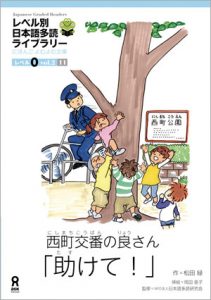
この本はおもしろいです。たくさん新したんごがあります。りょうさんは忙しくて、しんせつです。
This book is very interesting for people to read while learning some new vocabularies. You can easily understanding this story with the picture. I recommend this book to JPN 110 students.
Japanese Tadoku Books by Students
Smith College Tadoku Project

この本はおもしろいです。たくさん新したんごがあります。りょうさんは忙しくて、しんせつです。
This book is very interesting for people to read while learning some new vocabularies. You can easily understanding this story with the picture. I recommend this book to JPN 110 students.
I really enjoy this book! This book describe a day into 東さん’s life. The author uses a lot of the vocabulary we learned in the Genki textbook, like the time, waking up, walking to work, and showering, etc. The reading is very simple and there’s not a lot of kanji so I don’t have to be super stress about what the meaning is. The pictures also very help into comprehending if you are slightly confused about what the new vocabulary is. Overall, I recommend this book to first year students! Great story with detailed information!
このほんはとてもおもしろくて、ちょうとむずかしです。
The book is very interesting about the life of たろうくん and showing what he did during the school break. The drawing is very cute and it’s pretty self explanatory. There were some phrases and vocabulary that I didn’t know, but I made my guess based on the image the writer provided and the words in the sentences.
I definitely recommend this story for 110 students like me because it’s not too hard to read. The sentences are short and the pictures make you excited to read more!

この本は私のレベルのために難しいと思いました。話を三つ読んで、一つだけを読んだ時パンチラインを分かって、本当に笑いました。その話は「おにはそと、ふぐわうち」という42のページから始まる話です。それは楽しかったから、をおすすめします!他の読んだ話は「おばけのたまご」と「かさは売れたが」です。「おばけ」はちょっと分かりにくかったですが、「かさ」の方がやさしかったと思います。でも、たくさん話があるから、他のも読んでみてください!
Comprehension of these short funny stories was pretty tough going for me. If other 2nd Years want a challenge, then I recommend this; but it’s probably better suited to 3rd Years. That being said, I only selected three of them this time around (there are many many short stories in this collection), so if you read any of the others, let me know what you think!
この本はおもしろいです。私はたくさん大豆についてしりませんでした。どこで大豆は来るから習いました。ずがはいいでした。たくさん食べ物のずががありました。やさいについてを読みたかったらこの本はいいです。
This was a very informational book about soybeans. It goes into detail of where this is found in food products and what dishes they are found in. There were drawn picture examples of people eating the dishes and actual pictures of the food products made out of soybeans. This was easy to read and informational, the kanji wasn’t too hard, some of the captions on the picture have kanji we haven’t learned yet, but the rest was easy.
このマンガの本で、色々な日本の昔ばなしが集まれています。一番目の話しはこの本の中で一番長い物語で、竹取物語です。竹取さんはある日竹を取りながら、小っちゃい女の子を見つけます。寂しくて、子供がいない竹取さんと奥さんはかぐや姫という名前を付けて、育てます。かぐや姫は大人になる時、とても美しいのでかぐや姫と結婚したい男性が多いです。でも、かぐや姫は結婚したくないので、男性に挑戦することにします。そういう物語です。かぐや姫の物語の後で、色々な短い昔ばなしが入っています。面白い本です。
I would recommend this book to third and fourth year students, and possibly ambitious second-year students as well. There’s a lot of vocabulary that we don’t learn in class, but there are also helpful foot/side-notes that explain some of the vocabulary and historical references. The art style in the book is pretty nice, and that makes it fun to read, as well as the fact that the stories are pretty interesting.
この文章は繰り返しますから、「風と太陽〜イソップ物語より〜」はとても簡単です。たくさん前学期の単語からがあります。簡単すぎますから、面白くなかったです。でも、あなたは早く読むことができます。
Since the sentences repeats itself, Wind and Sun~Aesop’s Fables~ was extremely easy. There were many vocabulary words from last semester. Because it was a little bit too easy, I didn’t find the plot to be very interesting. But you can read this story really quickly.
これはとてもいいです。でも、ちょっと悲しいでした。いつわたしは読みて私は悲しくなりました。ハチは犬です。ハチはとてもいい犬です。ハチはオーナーがだいすきでした。最終的には何にはハチがもらって感動しました。
I would recommend this book because it gives a brief explanation of why there is a statue of a dog at a train station. I new about the statue and it was nice to read about it. It was a bit sad for me but at the same time there was a happy ending with how Hachi was and is remembered. There were very few words that we haven’t learned yet, but it was mostly easy to read.
ジョンさんは日本に行きました。飛行機の中で、きれいな女の子に合いました。同じい漫画を持ってきました。そして、ラフラフのはなしを始めました。このはなしは簡単で、面白いと思います。読んでくださいね。どころで、辞書を見ないほうがいいですよ。とてもとても簡単ですから。
Unlike the other explanatory books I have read so far, this story has some interesting plot lines. Although the story could easily happened in any other context, I enjoyed this book. I would recommend reading it just for a change, but for those of you who want to target books specifically link to Japanese culture or classic tales, maybe you can skip this.